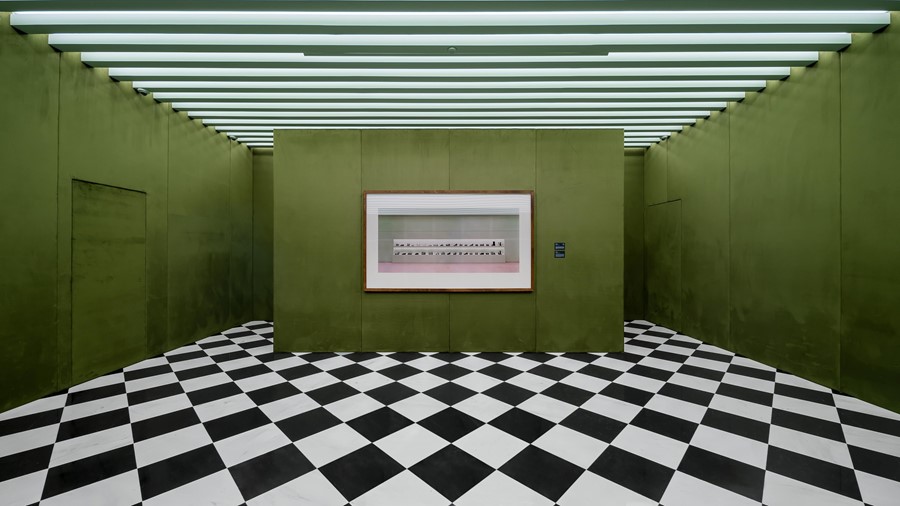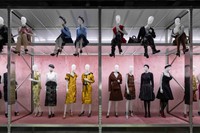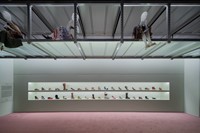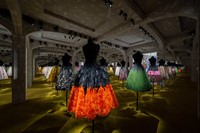Staged at the Start Museum in Shanghai, Pradasphere II sees the Italian house interrogate the meaning of itself via more than 400 artefacts
Back in 2014, Prada staged an all-immersive exhibition they called the Pradasphere, which still ranks as one of the best fashion exhibitions I’ve ever seen – and many others agree. It was a deep dive into what the designer Marc Jacobs famously declared “the Prada-ness,” an ever-malleable quality which ceaselessly juxtaposes and sometimes paradoxically combines dichotomous notions of intelligence and banality, reality and fantasy, perversion and desirability. Yes, I think a lot about Prada.
The brand just inaugurated the long-awaited second installation of the Pradasphere – pragmatically titled Pradasphere II – in Shanghai at the Start Museum. It’s a space renovated by Jean Nouvel – fitting, because Prada loves major architecture – located in a historic building that formerly housed the Nanpu Railway Station, dating back to 1907. Future, past, new, old. All very Prada. Of course, a lot has changed at Prada across the almost-ten years since the first Pradasphere debuted – not only multiple collections for men and women, but a fundamental shift in the act of Miuccia Prada’s co-creative directorship with Raf Simons, beginning in 2020. So this second Pradasphere wasn’t so much a second part as a reconsideration of the first, alongside perhaps a reconsideration of what Prada may mean. Both Miuccia Prada and Raf Simons were directly involved in the curation, giving their take on Prada’s Prada-ness.
It delves back and projected forwards, through more than 400 artefacts, physical and digital. At the very heart, a corridor of almost fashion show ensembles, titled ‘magazzino’ – meaning warehouse, which is very Prada – are arranged by year, leading right up to today. It opens with an outfit from Prada’s debut collection in 1988 – staged, incidentally, in the villa where Simons himself now lives. That stripped-back look, of a white cotton poplin shirt with a wide-spread collar and pragmatic, industrial-looking chest pockets, worn over a plain belted wool skirt, was exit ten in that first show. Hauled out of an era of shoulder pads and pouf skirts, it not only seems modern today but still looks distinctly, defiantly Prada. This opening corridor – joined, later, by one devoted to menswear – is didactic in its chronology, running on both sides. What it manages to do, strangely, is highlight connections between disparate eras. If, say, 1996 is on your left, 2016 may sit on the right. And of course, you make connections between those clothes, between creative approaches, between aesthetic obsessions, silhouettes, fabric treatments. You notice the affinities, you spot the differences. It’s fantastic.
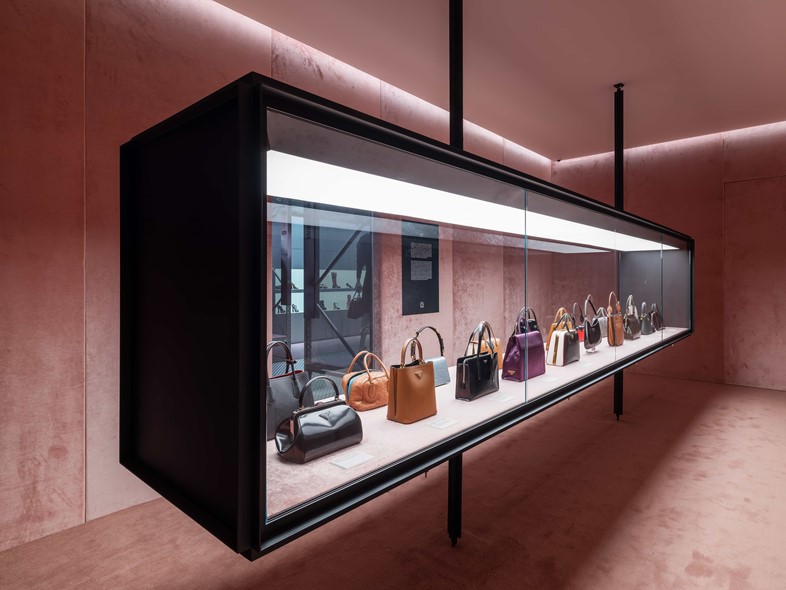
Slap bang in the centre is a space devoted to materiality. A few dozen skirts have been created by Prada – full, vaguely mid-century, they are a silhouette Miuccia Prada has returned to again and again – one that, arguably, has also enormously influenced Simons’ own womenswear designs, both before and after his appointment to Prada. These skirts are here used as canvases for exploration of the diverse fabrications that have become a hallmark of Prada – creased prints, crocodile cloqué, feathers and cellophane palettes bleeding into faux fur, crushed bottle-top palettes, crinkled metallic organzas. The clean shapes focus the attention on the fabrication – asserting that Prada’s innovation isn’t just in silhouette or shifting fashion, but in the very fibres of cloth. It’s a compelling centrepiece.
Rooms leading off this central ‘spine’ of the exhibition – literally its cerebral core, given that Prada always leads by the concept debuted in its fashion shows – are a series of rooms devoted to different themes. There are two devoted to Milano: one to Fratelli Prada, the original moniker of Prada’s flagship in the Galleria Vittorio Emanuele II, with moiré bags featuring carved clasps that formed the inspiration for the viral gurning head-clasped example on the Spring/Summer 2024 runway. The other, in monochrome, showcases what Miuccia Prada first designed when she took the helm in 1978, and invented nylon as a fabric of high fashion. Another features installations by Damien Hirst around other Prada bags, chroming them and pickling them in formaldehyde and, generally, rendering them as totems ready for worship. And the chronological aspect of the show is echoed in timelines of bags and shoes, illustrating both the profound shifts in obsessions that characterise Prada, and also the constants. The hyper-conservative top-handle bag is a silhouette repeatedly subverted; platform shoes appear again and again, framed in the signature green vitrines of Prada’s retail universe.
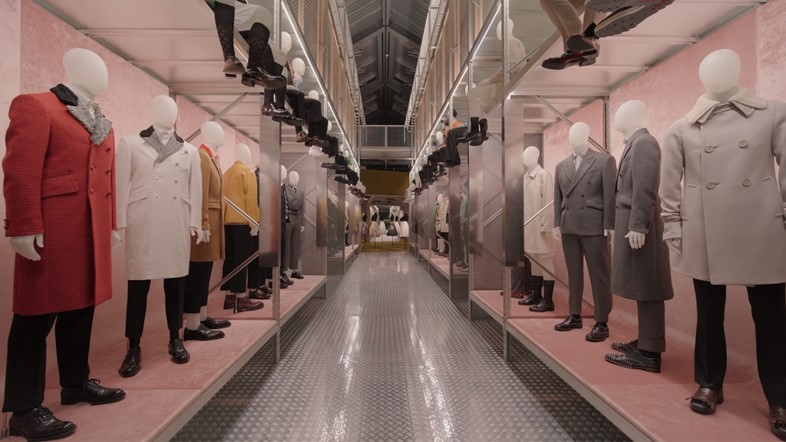
Even Prada’s stores are museum-worthy. Indeed, they’re already so fetishised by the art world that Andreas Gursky has devoted works to documenting serenely deserted Prada stores, and of course, Elmgreen & Dragset famously erected a lookalike store in Jeff Davis County, Texas – better known simply as Prada Marfa. Incidentally, thanks to Texas Department of Transportation zoning requirements, that piece has been technically designated a stand-alone museum since 2014 – with Prada Marfa as its only exhibit. Speaking of museums, the Fondazione Prada is of course also showcased, as are the aforementioned architectural endeavours of Prada, and rooms are devoted to the Luna Rossa and Parada Linea Rossa, and to Re-Nylon. It’s an exhaustive overview of the many facets of Prada, embedded in multiple immersive experiences: the Fratelli Prada room is hung with chandeliers; the warehouse displays its goods on perforated metal; Prada Milano is like stepping into one of Prada’s monochrome advertising images from the 1980s; Luna Rossa seems to set sail and the Fondazione Prada’s gilded walls are transported across the world.
For me, this is an introspective retrospective – in the best possible way. It is Prada interrogating the meaning of itself, looking inside to extract true meaning and to question what it means to be Prada – to discover that ‘Prada-ness’ that Jacobs abstractly talked about. That it is Miuccia Prada and Raf Simons both answering and asking these questions leads to a fascinating exchange, an exploration of creative possibilities, and a deep dive into Prada’s history, and how it has shaped its presence. I asked if the exhibition will travel; because I hope it will. The world should see the world of Prada.
Pradasphere II ran at the Start Museum in Shanghai from 7 December 2023 – 21 January 2024.
